At a Glance
Pros
- AAA PC games on almost any device
- Great performance at RTX 3080 tier
- Cheaper than a new graphics card
- Play games you already own
Cons
- Not every game is available
- 4K gameplay limited to Nvidia Shield TV
- Ethernet connection needed for best experience
Our Verdict
Nvidia GeForce Now offers one of the best game streaming services available in 2022, but you’ll have to pay a premium to get the top-tier experience, and holes in the game library could cause issues for some too.
While you’ve historically been locked to your local hardware when it comes to gaming, the introduction of cloud gaming services like GeForce Now had had a transformative effect on PC gaming.
By moving the processing from your computer to a remote data centre, you can now play RTX-enabled games at high frame rates on old PCs, laptops and even smartphones. Of course, there are plenty of options to choose from including Google Stadia, Xbox Cloud Gaming, PlayStation Now and Nvidia’s GeForce Now.
The question is, is Nvidia GeForce Now a viable alternative to local PC gaming for hardcore gamers? I’ve spent a few months with the new RTX 3080 tier on Nvidia’s cloud game streaming service, and here’s what I think.
Playing AAA games on almost anything
For those unaware of how services like GeForce Now work, the game is rendered remotely at one of Nvidia’s many data centres around the world and streamed to your display in real-time, much like streaming a video from Netflix.
That way, your device only needs to be strong enough to run the app or web browser you use to access it. That, and a fast, stable internet connection of course, with 50Mbps download speeds recommended for solid 1080p gaming.
Cloud gaming makes multi-device gaming a real possibility for those without the latest and greatest tech, as you’re able to make use of any old laptops, tablets or smartphones you might have gathering dust around the home. It has dedicated apps for Windows, Mac, Android and Shield TV, along with and browser-based web app for iOS devices, making it a pretty versatile system.
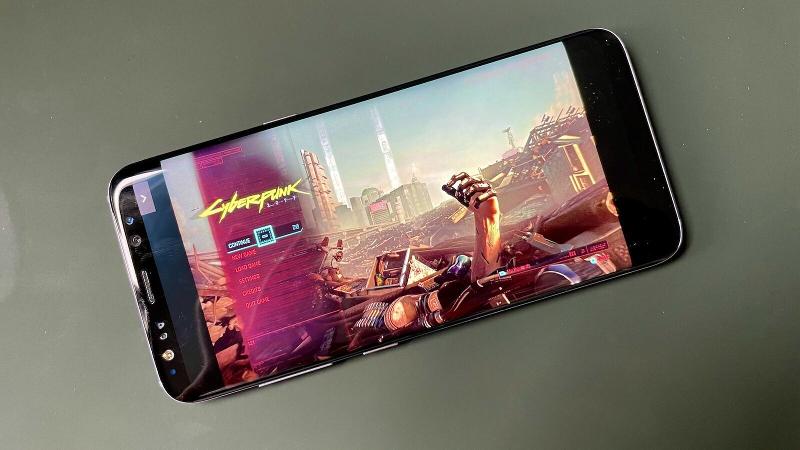
In fact, I found myself playing Cyberpunk 2077 on an old 2017 Samsung smartphone at one point. (Okay the screen was too small for my liking, but it is possible!). I then switched over to an iPad Pro for a while, before reconnecting on my 50in TV via my Nvidia Shield TV for a console-esque experience.
With the combination of cloud streaming and cloud-based game save systems, I could disconnect and pick up where I left off within a few seconds – although the initial boot of games could be improved, with some requiring keyboard and mouse input to boot the game in question (I’m looking at you, Guardians of the Galaxy!).
The Nvidia GeForce Now experience
The Nvidia GeForce Now experience is undoubtedly one of the best around right now, not just in terms of low latency performance but graphics, frame rate and detail, but much of that experience will depend on which tier of GFN you subscribe to.
Free
The GeForce Now experience starts with the free tier, allowing you to dip your toe into the waters of cloud gaming without an upfront cost – and for a free service, it’s very good. There aren’t restrictions on the titles you can stream, with access to the same titles as paid subscribers, and you can of course stream on any supported device.
The main limitation instead comes in the form of a queuing system; you’ll have to join a queue when you want to play a title, and depending on how busy the service is, that wait time could range from a few minutes to half an hour or more. You’ll also have to disconnect from your game after just an hour of gameplay and re-join the queue, so it’s not great for long gaming sessions.
The free tier also limits the quality of the gameplay experience, with no access to raytracing or HDR image quality, although you’ll get the same low-latency streaming experience as paid subscribers.
Like I say, it’s a good trial tier to see how it performs, but most serious gamers will likely opt for the Priority or RTX 3080 tiers.

Priority
The next level up, and the one that most fans will be familiar with, is the Priority tier – also called the Founders tier for those that subscribed in the early days of the service.
The Priority tier offers a comfortable middle-ground between the free and RTX 3080 tiers, ticking most boxes for a solid cloud gaming experience.
There is still a queue system admittedly, but you’ll get priority access to sessions when competing with free tier subscribers, and the game session length is upped from 1 to 6 hours before you’ll have to disconnect and re-join the queue.
Crucially, there are improvements to the overall game quality on offer. Unlike the free tier, the Priority tier runs on Nvidia’s Turing architecture, which means you’ll be able to enjoy raytracing and DLSS in supported games on the service.
That translates to better on-screen visuals with more realistic lighting, and DLSS helps to boost performance in more demanding AAA titles – as amazing as the Turing tech of the RTX 20 series is, it’s not the ampere architecture of the most recent RTX 30 series.
That means you won’t be able to ramp most games up to the maximum graphics settings, especially if ray-tracing tech is enabled, but the stream still looks solid on most displays.
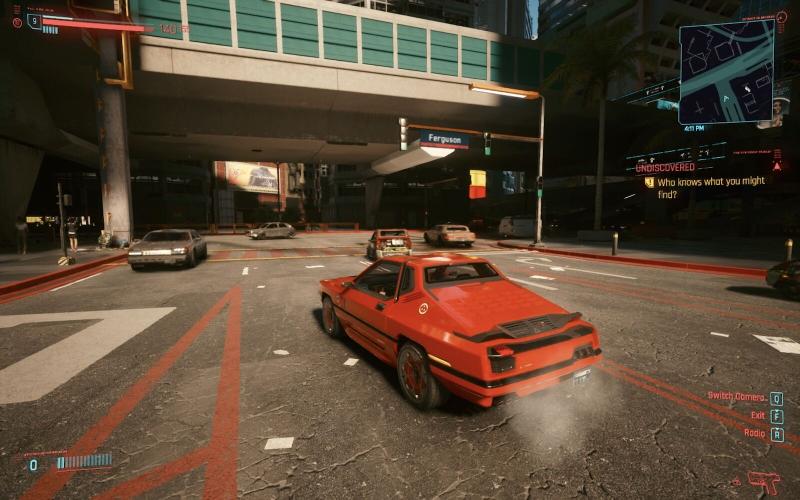
Gameplay is capped at 1080p@60fps on the Priority tier, which should suit casual gamers, but the most dedicated will want something more. It is available, but for that, you’ll have to subscribe to the newest RTX 3080 tier.
RTX 3080
The RTX 3080 tier, released at the end of 2021, feels like a new benchmark not only for Nvidia GeForce Now but cloud gaming services in general, offering a truly high-end experience with a look and feel not dissimilar to the Xbox Series X or PS5.
First up, as an RTX 3080 tier subscriber, you’ll get access to more powerful server-side technology to power your gameplay experiences. Despite the name it’s not actually powered by an RTX 3080, but rather a server equivalent with 24GB of VRAM – albeit at GDDR6 and not the GDDR6X of the standard RTX 3080, and at slightly slower clock speeds.
Despite the minor differences in spec between a local and cloud-based RTX 3080, the gameplay experience is near faultless in my experience. While most cloud gaming services tend to look a little soft on the detail front, that wasn’t the case when playing through Marvel’s Guardians of the Galaxy in all its ray-traced goodness on the RTX 3080 tier with most graphic settings cranked to the max.

It looks almost identical to Guardians of the Galaxy running on my PS5 locally, if not a little more detailed in terms of texture and atmospheric effects, and there was no notable lag at any time during my sessions.
Nvidia claims that GeForce Now offers lower latency than a game being played locally on an Xbox Series X, and while I don’t have the tech to prove that, it doesn’t feel laggy or delayed even in fast-paced FPS titles.
It’s truly an impressive feat of engineering, especially when you consider how cloud gaming works. To do all that with no noticeable input lag is no easy task, that’s for sure.
Part of the reason why games look so detailed on the RTX 3080 tier is down to the improved resolution and refresh rates available. While other tiers are limited to 1080p@60fps gameplay, those on the RTX 3080 tier can boost gameplay up to 1440p@120fps in supported titles on PC – ideal if you’ve upgraded to a more detailed 1440p PC monitor.
The ultimate experience takes place on Nvidia’s own Shield TV, where gamers can stream games at up to 4K@60fps – internet permitting, of course.
For me, the Shield TV is the best way to play GFN titles in all their ray-traced glory, providing something close to the console experience on the big screen without the need for a big expensive console or PC, but it would be nice if PC gamers also had the option.
Maybe it’ll happen in future, but for now, you’ll need to fork out on one of Nvidia’s (increasingly affordable) Shield TVs to make use of 4K cloud gaming.
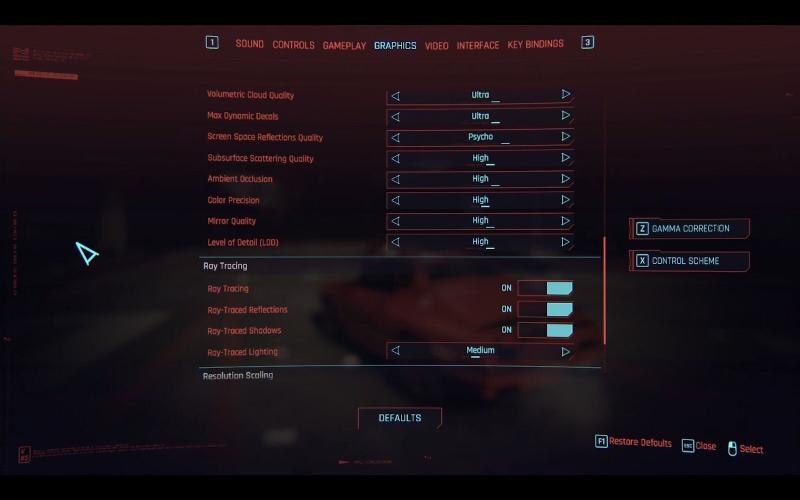
I want to point out that I used an Ethernet connection when streaming at 4K on the Shield TV to provide a solid reliable gaming experience – and it’s what I’d recommend to others serious about high-quality cloud gaming, as the experience can get a little spotty over Wi-Fi.
During Wi-Fi testing, I noticed the bitrate would occasionally drop and on one occasion the game stopped accepting my controller input for a couple of seconds, but these aren’t what I’d call immersion-breaking problems – more minor niggles that can be fixed with a stable wired connection.
It’s also worth mentioning that the RTX 3080 tier offers the longest play session available at 8 hours, and you’ll get the fastest access to sessions during busy periods too, so it really does offer the best GFN experience for those that can afford it in its six-monthly subscription form.
Game availability
While GeForce Now offers one of the most compelling cloud-based gaming experiences available right now, there is a catch: not every game is available on the platform.
Unlike streaming services like Shadow that provide a complete PC experience allowing you to install what you like from where you like, Nvidia’s option is more limited in its offering.
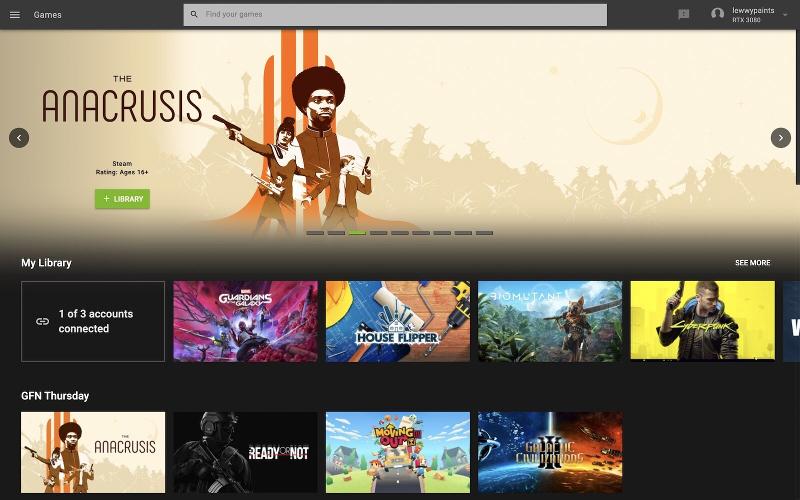
It officially supports Steam, Epic Games Store, GOG and Uplay, but not all titles on those digital storefronts are available – it seems that developers need to specifically whitelist streamable titles, and that availability shifts on a weekly basis.
That’s great, as it means new titles are added to the service every Thursday, but it also means that titles can be removed at a moments notice.
That’s not to say there isn’t an impressive selection of supported games. There are over 1000 available to stream at the time of writing, with Netflix-esque sections to help discover supported titles based on genre, RTX support and more, but there are notable gaps in its offering.
In fact, publishers including Rockstar, Bethesda and Activision have outright refused to feature their titles on Nvidia’s service to date, meaning you won’t be able to stream games like GTA V or Call of Duty Warzone.
It is a frustrating limitation that seemingly stems from publishers rather than Nvidia itself, and while I personally hope that the availability expands over time, the murky waters of game publishing mean it’ll probably never have every single game you’ll want to play.
Pricing
When it comes to Nvidia GeForce Now, the service is split into three tiers: free, priority and RTX 3080.
The free tier is, unsurprisingly, completely free to use with the restrictions noted earlier. The next step up is the Priority tier, which comes in at an affordable £8.99/$9.99 per month with 6-hour gaming sessions and priority queue jump.
But, for the most dedicated gamers, the only acceptable tier is the top-end RTX 3080 plan. Offering the best performance of any tier to get the best out of AAA titles, the longest gameplay sessions and the best resolution and refresh rate, it’s a premium experience with a price tag to match.
Unlike the priority plan, the RTX 3080 plan is only available in 6-month blocks at £89.99/$99.99 a go. That does work out to only £14.99/$16.60 per month, but it’s a big amount to pay out in one go – although arguably much less than the cost of the equivalent 30 Series GPU.
Those interested in trying out the service can sign up from the Nvidia GeForce Now website.
If that seems a bit pricey for your needs, there are plenty of other game streaming services available with other perks. We outline our top picks in our best game streaming services chart.
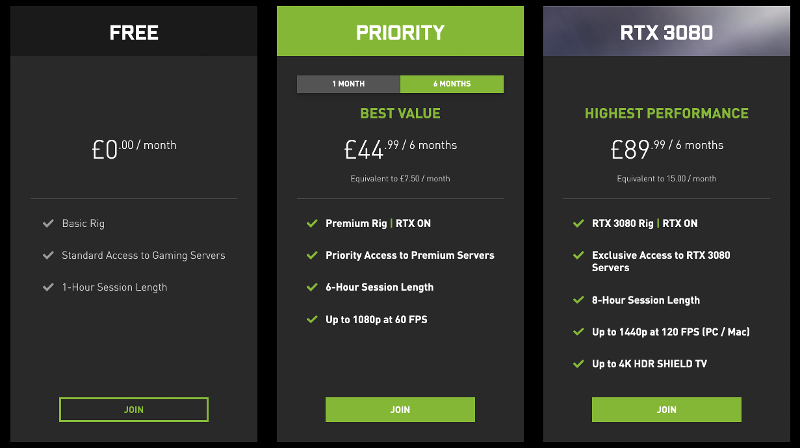
Verdict
Of all the cloud gaming services available at the moment, it’s Nvidia GeForce Now that resonates most – and it’s down to a couple of things.
First, and arguably most importantly, I don’t have to re-buy games on the platform as I do with Google Stadia, allowing me to enjoy games that I already own without additional cost, and games bought on the platform will be mine to own indefinitely, not just for the length of my GFN membership.
But secondly, it’s the performance on offer. When cloud gaming was first introduced, there was still latency issues that’d make playing games – particularly competitive titles – near-impossible, but Nvidia seems to have put that to bed with GeForce Now in 2022. I didn’t notice any latency issues or lag during my gaming sessions, aside from one disconnection during a Wi-Fi-connected session.
The RTX 3080 tier is, unsurprisingly, the best of the three tiers, offering Nvidia’s latest RTX technology with improved resolutions and framerates, allowing the latest AAA titles to shine in their ray-traced glory.
It was hard to be disappointed with the quality on offer on PC, but it’s the 4K@60fps performance on Shield TV that truly blew me away with an experience almost identical to that of a next-gen console. It’s just a shame that quality isn’t available on other 4K devices like PC.
The only real disappointment is game availability; while several PC storefronts are supported, there are massive gaps in the service’s offering, including key titles like Call of Duty Warzone and GTA V. It could improve in future, but I doubt there will ever be a time where you can play anything on GeForce Now.
Still, if you’re on the hunt for a multi-device cloud gaming service that offers something close to a desktop gaming PC experience, you won’t find any better than Nvidia GeForce Now and, in particular, the RTX 3080 tier.









